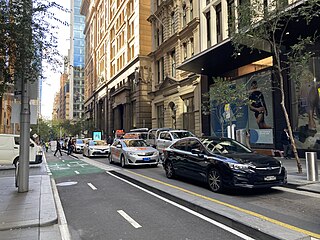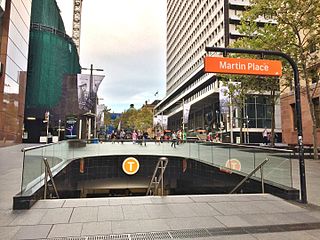
See also: Alleyway

Pitt Street Mall is the pedestrianised section of Pitt Street in the Sydney central business district, in the Australian state of New South Wales. Running for approximately 200 metres between Market Street and King Street, it is one block long and one of Australia's busiest and most cosmopolitan shopping precincts. Floorspace rents are the highest in Australia, in part due to other cities' shopping precincts being longer. In 2015, its rents were the fifth-highest in the world in terms of city streets.

Wynyard railway station is a heritage-listed underground commuter rail station located in the north-west precinct of the Sydney central business district, in New South Wales, Australia. The station opened on 28 February 1932 to coincide with the opening of the Sydney Harbour Bridge.

Pitt Street is a major street in the Sydney central business district in New South Wales, Australia. The street runs through the entire city centre from Circular Quay in the north to Waterloo, although today's street is in two disjointed sections after a substantial stretch of it was removed to make way for Sydney's Central railway station. Pitt Street is well known for the pedestrian only retail centre of Pitt Street Mall, a section of the street which runs from King Street to Market Street.

George Street is a street in the central business district of Sydney.

Rundle Mall is a pedestrian street mall located in Adelaide, South Australia. It was opened as a pedestrian mall in September 1976 by closing the section of Rundle Street between King William Street and Pulteney Street, to vehicular traffic. The street continues as Rundle Street to the east and Hindley Street to the west.

The Sydney central business district (CBD) is the historical and main commercial centre of Sydney. The CBD is Sydney's city centre, or Sydney City, and the two terms are used interchangeably. Colloquially, the CBD or city centre is often referred to simply as "Town" or "the City". The Sydney city centre extends southwards for about 3 km (2 mi) from Sydney Cove, the point of first European settlement in which the Sydney region was initially established.

Martin Place is a pedestrian mall in the Sydney central business district, New South Wales, Australia. Martin Place has been described as the "civic heart" of Sydney. As home to the Reserve Bank of Australia, the Commonwealth Bank, Macquarie Bank, Westpac and other corporations, it is also a centre of business and finance. The Sydney GPO is also located on Martin Place.

Martin Place railway station is a heritage-listed underground commuter rail station located on the Eastern Suburbs line, serving the Sydney central business district in New South Wales, Australia. Named after Martin Place, it is served by Sydney Trains T4 Eastern Suburbs & Illawarra Line services and NSW TrainLink South Coast Line services. It was designed by Fowell, Mansfield Jarvis and McLurcan and built from 1973 to 1979. It was added to the New South Wales State Heritage Register on 2 April 1999.

The Queen Street Mall is a pedestrian mall located on Queen Street in the centre of Brisbane, Queensland, Australia. The mall extends approximately 500 metres (1,600 ft) from George Street to Edward Street, and has more than 700 retailers over 40,000 square metres (430,000 sq ft) of retail space, which includes six major shopping centres. It was intended to bring more people into the central business district.

Centre Place is a laneway and pedestrian precinct in Melbourne, Australia. It runs north from Flinders Lane to Collins Street, between Elizabeth Street and Swanston Street.

The Strand Arcade is a heritage-listed Victorian-style retail arcade located at 195–197 Pitt Street in the heart of the Sydney central business district, between Pitt Street Mall and George Street in the City of Sydney local government area of New South Wales, Australia. It was designed by John B. Spencer, assisted by Charles E. Fairfax; and built from 1890 to 1892 by Bignell and Clark (1891), with renovations completed by Stephenson & Turner (1976). The only remaining arcade of its kind in Sydney, the property was added to the New South Wales State Heritage Register on 13 December 2011.

The General Post Office is a heritage-listed landmark building located in Martin Place, Sydney, New South Wales, Australia. The original building was constructed in two stages beginning in 1866 and was designed under the guidance of Colonial Architect James Barnet. Composed primarily of local Sydney sandstone, mined in Pyrmont, the primary load-bearing northern façade has been described as "the finest example of the Victorian Italian Renaissance Style in NSW" and stretches 114 metres (374 ft) along Martin Place, making it one of the largest sandstone buildings in Sydney.

The Julian Ashton Art School is a heritage-listed former offices and now art school and retail store at 117-119 George Street in the inner city Sydney suburb of The Rocks in the City of Sydney local government area of New South Wales, Australia. It was designed by E. Lindsay Thompson and Spooner & Dixon. It is also known as Gallery and Shop. The property is owned by Property NSW, an agency of the Government of New South Wales. It is currently tenanted by the Julian Ashton Art School. It was added to the New South Wales State Heritage Register on 10 May 2002.

MidCity is a shopping centre in the Sydney central business district. It is located on Pitt Street Mall, adjacent to Westfield Sydney, The Strand Arcade and is diagonally opposite Glasshouse. MidCity has over 24 stores across Fashion, Beauty, Fitness and Lifestyle.

The Melbourne central business district in Australia is home to numerous lanes and arcades. Often called "laneways", these narrow streets and pedestrian paths date mostly from the Victorian era, and are a popular cultural attraction for their cafes, bars and street art.

The Palings Building is a heritage-listed retail building located at 86 Queen Street, Brisbane City, City of Brisbane, Queensland, Australia. It was designed by Richard Gailey as one of a row of four identical buildings and built from 1885 to 1919 by Patten & Son. Two of the four buildings have since been demolished while a third survives but is incorporated into another building. The Palings building was added to the Queensland Heritage Register on 21 October 1992; at that time, the building was used for the City International Duty Free store.

Glasshouse is an office and retail building in the Sydney central business district. It is located on the corner of King Street and Pitt Street Mall, adjacent to Westfield Sydney and is opposite MidCity, The Strand Arcade and Sydney Arcade.

The Cumberland Place and Steps are heritage-listed steps and a laneway located at Cumberland Place, in the inner city Sydney suburb of The Rocks in the City of Sydney local government area of New South Wales, Australia. It was built from 1807. It is also known as Suffolk Lane; Stubbs Lane; Gloucester Lane; and Cribb's Lane. The property is owned by Property NSW, an agency of the Government of New South Wales. It was added to the New South Wales State Heritage Register on 10 May 2002.

The Bulletin Place Warehouses are a series of three heritage-listed former warehouses and now souvenir sales office, commercial offices, health club, storage area, and restaurant located between 6–18 Bulletin Place, in the Sydney central business district in the City of Sydney local government area of New South Wales, Australia. The warehouses were built from 1880 and have variously been known as the San Francisco Restaurant. The property is privately owned. It was added to the New South Wales State Heritage Register on 2 April 1999.
































